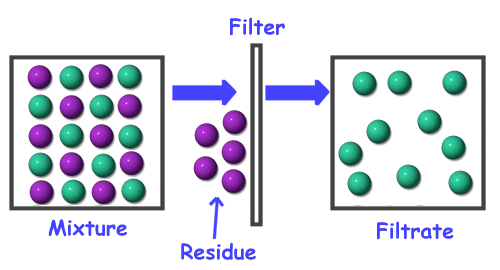Filtering is a way of separating very small particles of a solid which are suspended in a liquid. E.g. Mud mixed with water. The video above shows how you can do this using natural materials that you can find in the countryside. In school we can use filter paper and a beaker to do this but it is trickier at home but we will have a go later.
The key idea of filtering, is that only particles smaller than the gaps in the filtering material are allowed through. The rest are caught in the filtering material because their particles are too large to go through the holes. The principle is similar to sieving.
Task: Please watch the video clip below:
Why do we want to separate mixtures?
All the way back to Ancient History, industrious humans have separated mixtures in order to obtain the specific substances that they need.
Separation Processes
The way in which different substances in a mixture are separated is called a process. There are a number of different processes used for separation. Many of them are very complex and involve dangerous chemicals or high temperatures. A lot of important industries in the world today are based on separation processes.
Filtration
One common method of separation is filtration. Filters are used everywhere. We use them in our houses to filter dust and mites out of the air we breathe. We use them to filter impurities from our water. We even have filters in our bodies such as our kidneys which act as filters to get bad stuff out of our blood.
The filtration process is generally used to separate a suspension mixture where small solid particles are suspended in liquid or air. In the case of filtering water, the water is forced through a paper that is made up of a very fine mesh of fibres. The water that has been run through the filter is called the filtrate. The particles that are removed from the water by the filter are called the residue.

Below is a link to BBC bitesize, for more details about filtering.
www.bbc.co.uk/education/guides/zgvc4wx/revision
We have now learnt several different ways of separating mixtures. Please go through this power point to refresh your memory about the,. Decanting is a way of separating liquids which do not mix together such as oil and water.
Task: Using the information from the power point and your understanding from our work over previous weeks, please complete the worksheet, sorting out which labels need to go in which columns. If you do not have access to a printer then copy out the table in your book and fill in each section. Please send your work in the science channel of Teams. Thank you.
Optional extension activity: Below is an optional practical activity to link with this lesson's work on filtering. Click on the picture of the water filter below. It will take you to the National Geographic Website where you will find the instructions. If we were at school we would do a similar activity.